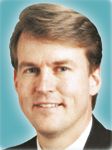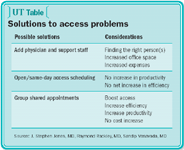Article
The group shared appointment: How it works and how it helps
According to a 2004 AUA survey, urologists are working harder and longer than ever. An aging population combined with the training of fewer urologists (many of whom wish to limit work hours) has created an unprecedented workload.

Meanwhile, patients expect rapid and high-quality access to their urologists, regardless of such demographic changes. Few established urologists have the capacity to easily increase either the number or duration of visits in order to meet this need. Therefore, the most common solution is to overbook and limit the duration of visits at the potential cost to patient satisfaction and quality of care (see table).


The GSA: What it is and is not
The GSA concept was originally developed by Edward Noffsinger, PhD, at Kaiser Permanente of Northern California, to improve access and quality of care through enhanced patient education and support. This model has expanded to many academic and private practices throughout the country, including The Cleveland Clinic, where urologists at the Glickman Urological Institute have used GSAs for the past 3 years.

It is important to understand that the GSA is neither "group therapy" nor a lecture. It is a one-on-one visit in the presence of patients with similar conditions that allows the patient to benefit from the extended time of a GSA and to learn from the interactions of the physician with other patients. Instead of a rushed follow-up visit in a few minutes, they will experience a 90-minute visit shared with people with similar conditions. Insurers may need reassurance that this is the case, and that the GSA will not devolve into a "class."

2 Commerce Drive
Cranbury, NJ 08512
All rights reserved.





